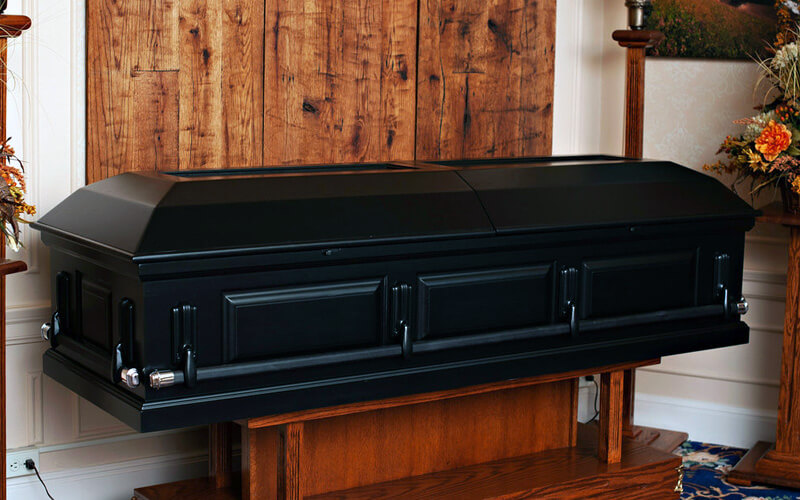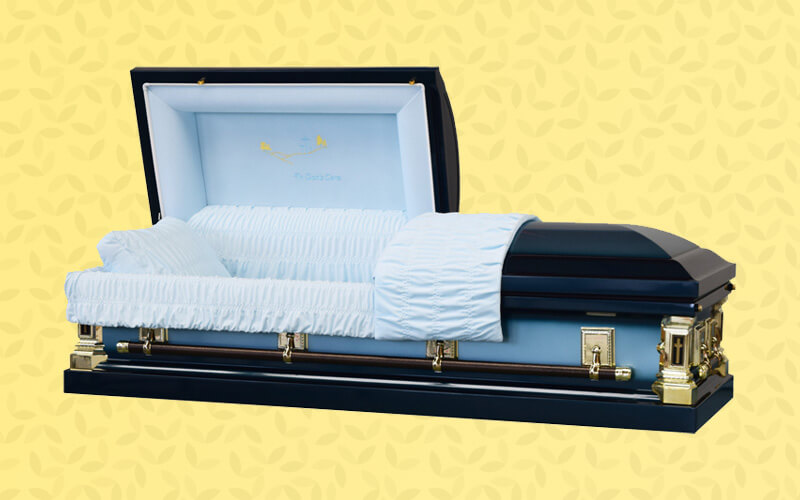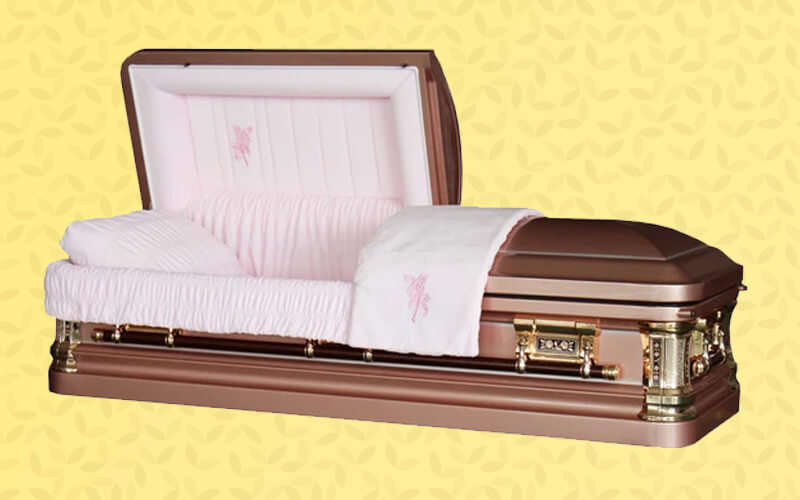When it comes to honoring a loved one’s memory, selecting a casket is an important decision.
With various casket colors available, each with its own unique meaning, it can be difficult to know where to start.
That’s why we’ve put together this comprehensive guide to explore 15 of the most popular casket colors, what they symbolize and how to choose the perfect casket for your loved one.
In This Article
Casket Colors and What They Mean
White

White caskets are typically made out of metal and have been popularly associated with innocence, purity, perfection, and simplicity for a long time.
A casket in this color combines modern elegance and a minimalist aesthetic, starkly standing out from its surroundings.
White is also a representation of new beginnings in some cultures. Things don’t necessarily end with death – death may just be the beginning of the afterlife.
A benefit of a white casket is that it complements all colors. You don’t need to worry about matching flowers.
Brown
Brown is a color associated with wholesomeness, straightforwardness, and honesty. It perfectly suits those who were just that in their lifetime.
Brown caskets are typically made from wood, and most often, the original coloring of the wood is retained in the final casket.
If you’re looking for a more luxurious option, you can opt for alternative brown finishes such as mahogany and cherry.
Cherry wood, with its gorgeous purplish-reddish-brown hue, finds a perfect partner in white interiors and complements nearly any kind and color of flower placed next to it.
Mahogany is a similar shade to cherry wood but features more orange, making it a warmer color. Mahogany exteriors pair well with ivory or white interiors and, like cherry wood, can complement almost any flower color.
Black

Sophisticated and bold, black caskets are usually used in more traditional, formal settings for people (generally seniors) who were highly respected in their community.
Black is also a color associated with modesty and timelessness and can be used for such people.
Black is also associated with sadness, which suits it too somber occasions like funerals.
Black caskets are usually made of steel or stained wood. Like white caskets, the interior can be any color, though ivory/white are the most popular.=
Pink
Though many people see pink as purely “girly,” it’s so much more – it can represent love, sweetness, sentimentality, fun, adventure, and romance, depending on the shade.
If your loved one was energetic, always searching for a new adventure, nothing would represent them better than a pastel pink or dusty pink casket.
Blue

Blue can hold many meanings since it’s such a multifaceted color. For some, it can mean trustworthiness and communication, while for others it can mean calm, serenity, tranquility, and peace.
Many find that blue is also perfectly in line with funerals since it’s a color that represents sadness.
Some cultures see it as a color of hope, symbolizing healing, paradise, and heaven.
Blue caskets are well suited for those who were the epitome of confidence and friendliness in their lifetime.
Blue is a shade that pairs well with pastel interiors such as peach, white, and pink. They also go well with gold and silver.
If you’re looking for something more sophisticated, consider dark blue shades, such as navy.
Gray
Gray is commonly used to denote isolation, neutrality, and equitability. A gray casket is well suited for one who didn’t reveal too much of themselves to the world right up to the very end.
Gray is also associated with stability and can be the casket color of choice for those who were calm, dependable, and reliable during their lives.
Silver
Silver is purifying, calming, emotional, mysterious, and moving like the moon and the flowing tides.
Unlike gray, silver is more opulent, due to which it’s also associated with fame, glamor, and wealth.
Silver is sometimes also seen as a feminine color. Although only in some circumstances.
Most of the time, silver caskets are made from steel.
A combination of vibrant flowers (such as deep purples and dark reds) and a silver casket can present a very elegant image.
Green

Not to be confused with a “green casket,” a green colored casket can be symbolic of a number of things, such as wealth, excitement, and nature – the quality it represents will depend on the shade of green you choose.
For example, light green signifies vitality, growth, and renewal, perfect for those who embody these characteristics in their lifetime. In contrast, a dark, rich green will represent abundance, wealth, and fame, suiting rich, wealthy folks.
A green closer to khaki may represent the army and like navy blue is ideal for those who served in the armed forces.
Orange
Some may think orange would be out of place at a funeral, but this vibrant color represents energy, health, and activity, making orange caskets perfect for those who were always the life of the party.
Orange is also associated with youthfulness and creativity and can therefore be used for adventurous, creative, and young folks.
An orange exterior pairs well with a warm yellow, nude, or white interior.
Red
Passion, adventure, energy, love, and intensity are some things that red can represent. If your loved one lived a life of color, power, and confidence, red may be the casket color to settle on for them.
However, red should be treated with care, as it can easily and quickly go from classy to over the top.
Use warmer colors inside the casket, such as a light pink or white nude, to tone down the vibrancy, with fewer ornaments and flowers.
Yellow
Like orange, yellow may come across as an unusual choice of color for a casket. Still, this positive color perfectly represents those who brought “sunshine” into the lives of others.
To tone down the color’s brightness and impart a bit of seriousness, a white interior can help.
Maroon
A maroon casket can look gorgeous, and this deep color can perfectly represent someone passionate, spiritual, wise, and deep.
Maroon is available in many intensities, so you can go as light or dark as you want.
A maroon casket will pair with white or ivory interiors, surrounded by white or pale pink flowers.
Rose Gold

Rose gold is among the more modern color options to join the list, but it can make an attractive choice when paired with gold, silver, or light-colored hardware and liners.
Rose gold can be quite matronly, and a rose gold casket can make a great choice for someone who was highly maternal, caring, and affectionate.
Purple
Royal, noble, and spiritual, purple can be a beautiful choice for someone who passed at a young age or lived a life of luxury, depending on the shade you choose. Purple caskets pair well with velvet interiors.
Copper
Typically made from metal, copper caskets may seem bold, but they can come across as really warm when paired with an ivory interior. This color is perfect for those incredibly warm but projected a tough interior.
Choosing the Right Casket Color
The meaning and symbolism of a casket’s color are important, but there are other practical considerations to think about as well when making a choice:
The Type of Funeral Service
What kind of funeral service is being held for the deceased? A religious, traditional, or contemporary one? The chosen casket color must align with the ceremony’s nature.
If you’re hosting a religious or traditional ceremony, it is generally advisable to go with conventional choices like white, silver, brown, and black.
For a more contemporary service, brighter colors including the blues, purples, and pinks are perfectly acceptable.
For a funeral service amid nature, you may want to consider orange, yellow, beige, and of course, green.
The Deceased’s Choice
Many people think about and may have expressed their casket color preference in advance to make things easier for their loved ones. It’s worth asking friends and family if this was the case.
Sometimes, a casket may not even figure in the deceased’s final instructions. They may have stated preference for an urn or even an inexpensive option like a pine or painted cardboard casket.
If so, all you need to do is fulfill their wishes.
Weigh All Your Options
Though this may be difficult, especially in cases where a demise is least expected, comparing the available options will ensure that you don’t blindly buy the first decent-looking casket you come across.
Take your time. You may find a color that better represents everything about your loved one and their personality. You might also find a better price if you shop around.
Consult with friends and family. In a perfect world, you can settle on a casket with which everyone is happy with.
Related Article: 7 Best Caskets: Buyer’s Guide & How to Choose One [2023 Guide]
What Is the Most Popular Color Casket?
Many people currently opt for neutral shades such as black, brown, white, mahogany, and cherry for caskets, making these the most popular colors.
However, my view is that the best casket color is chosen by friends and family that truly represents their loved one’s character and beliefs while also suiting the ceremony.
The Final Word
Colors speak volumes. The right casket color – one that embodies your loved one, their principles, and their personality – is a beautiful way to honor them.
If the decision seems too overwhelming for you in a time of grief, don’t be afraid to lean on a friend or family member and let them help you.
And remember, there is no such thing as a perfect casket. As long as your loved one’s life and impact on people are celebrated and honored, and you get to give them a proper farewell, those are the things that matter most.
If you have any further questions about casket colors or anything else beyond life, please feel free to leave a comment below or get in touch.











